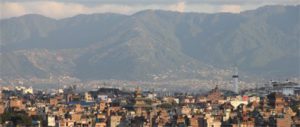I am holding a small white pebble that I picked up recently in Turkey. Two thousand years ago it was part of a force of nature, a tsunami that killed a city. Today, our cities themselves are like a global tsunami. Researchers from Yale, Arizona State, Texas A&M and Stanford universities predict that, by 2030, urban areas will expand by 1.5 million square kilometres – nearly the landmass of Mongolia – to meet the needs of an estimated 1.47 billion more people living in urban areas.
That isn’t the worst of it. “It is likely that these cities are going to be developed in places that are the most biologically diverse,” explains Karen Seto, the study’s lead author and associate professor in the urban environment at the Yale School of Forestry & Environmental Studies. “They’re going to be growing and expanding into forests, biological hotspots, savannas, coastlines – sensitive and vulnerable places.”
Urban areas, for obvious reasons, have been expanding more rapidly along coasts. “Of all the places for cities to grow, coasts are the most vulnerable,” Seto says. “People and infrastructure are at risk to flooding, tsunamis, hurricanes and other environmental disasters.” According to Science Daily, the researchers examined key studies that had used satellite data to map urban growth and found that from 1970 to 2000 the world’s urban footprint had grown by at least 58,000 square kilometres, half the area of the US state of Ohio.
The reality may be considerably worse, however. “This number is enormous, but, in actuality, urban land expansion has been far greater than what our analysis shows because we only looked at published studies that used satellite data,” Seto warns. “We found that 48 of the most populated urban areas have been studied using satellite data, with findings in peer-reviewed journals. This means that we’re not tracking the physical expansion of more than half of the world’s largest cities.”
The drivers of urbanisation vary. Half of urban-land expansion in China is driven by a rising middle class, whereas the growing size of cities in India and Africa is fuelled primarily by population growth. A key factor is urban sprawl. Burak Güneralp, a researcher based in the department of geography at Texas A&M, says urban areas are growing faster than urban populations. “This massive urbanisation of land is happening worldwide, but India, China and Africa have experienced the highest rates of urban land expansion,” he explains. “Our study covered the 30 years from 1970 to 2000, and we found that urban growth is occurring at the highest rates in developing countries. However, it is North America that experienced the largest increase in total urban land.”
There is a flip side to all of this, Güneralp points out: “People who live in cities tend to have better access to health care, water and sanitation facilities, and cities are shown to be more efficient with regards to such things as energy consumption compared to rural areas.
“In cities, people exchange. They exchange ideas, experiences as well as materials. All these spur innovation and create business opportunities. Because of all these interactions, cities are the most likely places to come up with the solutions to the emerging environmental and economic challenges that we face.”
Meanwhile, the science of cities is jumping ahead in other areas. I encourage readers to watch a 51-minute video interview with Geoffrey West, past president of the legendary Santa Fe Institute, a non-profit research centre based in the US state of New Mexico. For me it was like stumbling on a treasure trove of answers to questions that have been nagging me for over four decades.
West begins: “I spent most of my career doing high-energy physics, quarks, dark matter, string theory and so on. Between 10 and 15 years ago, I started to get interested in the question of whether you can take some of the powerful techniques, ideas and paradigms developed in physics over into the biological and social sciences.”
He continues: “It is very clear from the beginning that we will never have a theory of biological and social systems that is like physics. Nothing approaching that can possibly be in these other sciences, because they are complex systems.” But he goes on to explain why much of his current work on the structures of social organisations, cities and companies nonetheless has its roots in biology: “The remarkable thing in biology…is that there was data, quite old and fundamental to all biological processes, about metabolism: here is maybe the most complex physical chemical process possibly in the universe, and when you ask how it is scaled with size across mammals, as an example to keep it simple, you find that there is an extraordinary regularity.”
His team discovered “a very simple power law”. Its applications seem to apply from the intra-cellular level up to ecosystems, across almost 30 orders of magnitude. The team is also now finding that it applies to the life-cycles and scaling of corporations. West asks: “Is New York just actually, in some ways, a great big whale? And is Microsoft a great big elephant? Metaphorically we use biological terms, for example the DNA of the company or the ecology of the marketplace. But are those just metaphors or is there some serious substance that we can quantify with those?”
The point, West argues, “is that all of the tsunami of problems we’re facing, from global warming, the environment, to the questions of financial markets and risk, crime, pollution, disease and so forth, all of them are urban. They all have their origin in cities. They have become dominant since the Industrial Revolution. Most importantly, they’ve been with us for the last 200 or 300 years, and somehow, we’ve only noticed them in the last 10 or 15 years, as if they had never been here. Why? Because they’ve been increasing exponentially.”
My Turkish pebble goes back on the shelf, but the challenge cannot be put away so easily. We must turn our cities – old and new – into powerful agents of the next, greener industrial revolution, ensuring that people do not cut themselves off from nature in ways that are damaging to both.
John Elkington is executive chairman at Volans and non-executive director at SustainAbility. His latest book is The Power of Unreasonable People. He blogs at www.johnelkington.com and tweets at @volansjohn.
Homepage image by Sarmu





